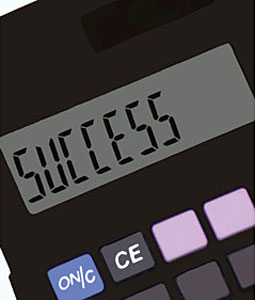
|
I recently hosted a 45-minute webinar for kitchen and bath dealers/owners/managers on how to improve close ratios. Here are some key points from the well-received presentation.
First, allow me to share a little personal experience on how I learned the importance of developing a system to improve the close ratio on quotes generated from the sales team at my business.
In my opinion, we had one of the best sales teams in the business. We taught and practiced showroom selling skills, but our close ratio was poor. Our salespeople would do a great job of putting together quotes for our clients, but (and this is big) they would file the quote and move on to the next prospect. We didn’t do a very good job following up on the hundreds of quotes generated. Sure, our folks were busy but the quote follow-up wasn’t a priority.
I harped on it to the point of frustration. Then I finally got smart and instituted a quote follow-up system. Prior to using this system, our close ratio was between 50% and 60%. That meant 40% to 50% of our labors didn’t produce results. Not good! After we religiously started following up each and every quote of $4,000 or more, our close ratio improved to about 85%. Wow! That was huge.
The Particulars
Just what is a close ratio? Good question. It is simply the percentage of quotes (of a predetermined size) that turn into orders. Example: You do a quote valued at $5,000. It turns into an order (a closed sale). Now for the next 90 days you track how many quotes valued at $5,000 or more also turn into orders. Let’s say you produce 30 quotes in that timeframe and 15 turn into closed sales. Your close ratio would be 50%.
I know for a fact very few of you track this important benchmark. So I am encouraging you to immediately develop a system that will tell you what your close ratio is. Select a dollar value of the quotes you want to track. I suggest something in the $2,500-$5,000 range. Then over a period of time, possibly 6-12 months (since sometimes it takes time for quotes to turn into sales), track how many of those quotes turn into orders. If your results are less than 75% in closed orders you’re doing something wrong. You’ve wasted a lot of time churning out quotes that don’t turn into sales. Time is money – so maximizing your return on time spent in developing quotes benefits you and your company.
When I was preparing to do the webinar I decided to find out if there was just one “magic” thing you could do to improve your close ratio. I Googled more than 15 different sites on the subject. I went to the books in my personal “selling skills” library and I even called several friends of mine that I consider to be experts in the field of selling skills. I was looking for that one silver bullet that would make it easy for all of you. My conclusion: There is no one easy step to improving the close ratio. It all comes down to great salesmanship and follow-through. I’m sure I already knew this. I just had to confirm it with all the outside sources I consulted.
Closing the sale is simply one of the steps in the selling process. Yes, selling is a process and a system, and each step must be learned and mastered. Learning these skills is not difficult. We have a daughter who is a radiologist. She went through 10 years of training to learn her skill. Learning selling skills can be done in six months! As you know by reading my columns, I believe in my heart and my head that this is the most important skill you must learn if you hope to be a successful showroom sales consultant. Sure, having design skills, computer skills, being a good “people person,” and having great product knowledge all contribute to that success, but learning and practicing selling skills is still No. 1!
Here are three very important actions you can and must do to improve the selling skills and the close ratio at your place of business:
- Develop a formal, written and comprehensive sales skills training program.
- Implement this selling system with your entire selling team.
- Have a sales manager who will be responsible for managing the program and the team.
This must be ongoing and never-ending! It starts with learning the basics and then practice, practice, practice. I played baseball in college. I was a pretty good hitter, but just like the big leaguers, everybody on the team took batting practice each day. Your sales training program must include lots of proactive, real-life experiences (i.e. role playing) and these exercises must be continually practiced.
Over the years, I have developed selling workshops for companies and wrote a 215-page selling skills workbook for ASA. In 2013, I will be delivering a series of webinars on this subject for ASA and its members. Whether you are an ASA member or not, you can buy this workbook and use it as part of your own customized sales training program.
You’ve heard me recite this frustration before, but until the majority of you finally start taking this seriously I will continue to harp on it. Ours is a selling business and very few of you invest the time, energy or money into teaching selling skills. It’s so easy and inexpensive compared to so many other things you do. Here’s a condensed version of the selling steps I’ve put together for your type of showroom sales.
First, and this is very important, the selling process is made up of a number of steps. Each step leads to the closing of the sale. Each and every step must be done very well. There are no shortcuts.
Here’s my seven-step selling process.
Prospecting for clients
Before you can do anything, you must have prospective customers calling you, coming into your showroom, visiting your website, etc. This is achieved through referrals (and this should be your No. 1 source of new clients), advertising, promotions, public relations cold calls and everything else you do to try and attract potential customers to your place of business.
The initial contact
You only get one opportunity to make that great first impression. It happens in a number of different ways: talking with someone viewing your website or an ad; the drive up to your facility; the first step through your front door; and the first words of greeting. There’s a system and a skill to make all this happen in a professional and a positive way.
Qualifying the client
Next to writing the order this is the most important step. You must ask a series of questions, be a great listener and then give answers and comments that will help you determine whether this client will be worth your time (and the client’s time). This all must take place in the first 15 or 20 minutes of meeting the new prospect.
Products, services, value points
Once you’ve qualified the prospect (and not before), you move on to this step. There’s a whole set of skills that need to be learned so it continues to lead to closing the sale.
Eliminating objections and concerns
Every prospect will have things on their mind that they’re not sure about. Your job is to identify them and make them go away. If you don’t, you won’t get the order.
Closing the sale
Yes, this is the most important step. If you’ve done a good job in Steps 1-5, this also is the easiest. Doing a great job with the first five steps makes this one almost automatic. Honest!
After sale follow-up
This is a step most of you ignore and don’t take advantage of. Hand-written thank-you notes, small gifts, a customer satisfaction survey, asking for referrals and rewarding those who give them to you, and obtaining testimonials are examples of little gestures that can be advantageous. Use this important past-customer database to promote additional business.
It wasn’t easy condensing an eight-hour workshop into 1,500 words, but you get the idea. To summarize, there are two things you must do if you want to improve the close ratio at your place of business:
- Sales training.
- Develop a quote follow-up system that is adhered to by every salesperson at your business.
If you would like more information on the upcoming ASA series of selling skills webinars or would be interested in doing a selling skills workshop at your place of business, drop me an email.
Happy selling!



